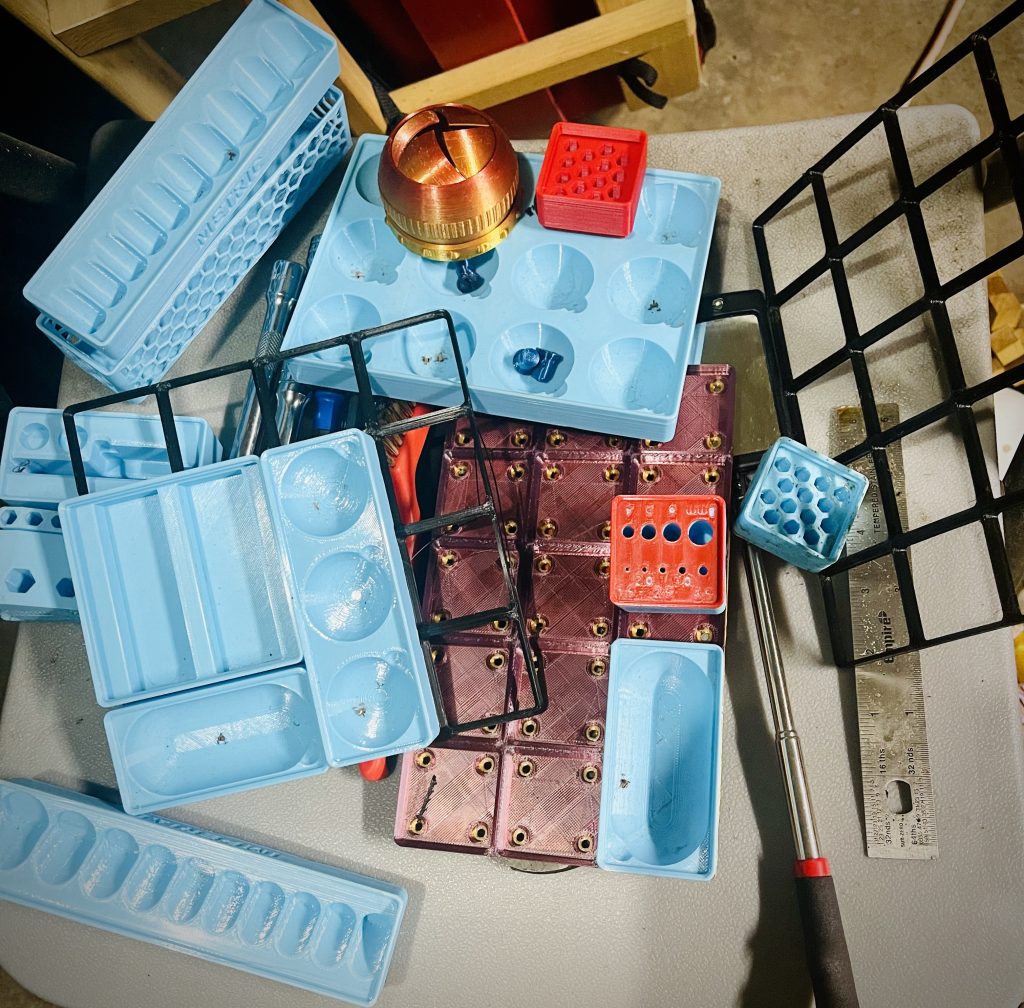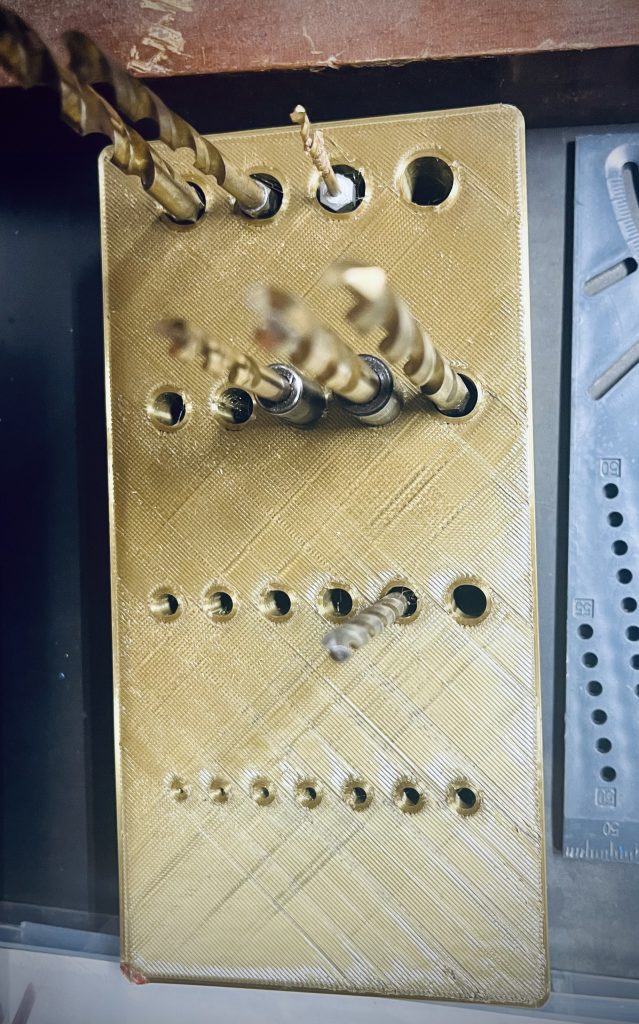What is Gridfinity? It’s a 3D printed organization system based on a printed grid of cubes, and you print out cubic holders that fit into the base grid. You can print just 1 cube for something like USBs or a line of them, or any configuration you want. It’s like Tetris, and each game part can house something else.
I remember when Zach Friedman came up with it, and it has been wildly popular since then. I’ve noticed. Whole shops have been organized around this system. I dipped my toes into it when it was originally introduced. And I don’t use it. Here’s why.
I am insanely organized. I am affected by my environment, and always am making sure lighting and my surroundings are comfortable in my mind, which means knowing where everything is and having it easily accessible. Organization is very important to me. So naturally, I was interested in Gridfinity.
I probably printed out close to 100 blocks for one purpose or another, mostly revolving around my workshop. Drill bits, sockets, driver bits, a place for my calipers, and so on.

My first concern is that it’s horizontal. When you arrange things horizontally instead of vertically, you automatically lose efficiency and workable room. It seems “childish” to me, too, to need to have everything displayed before you, and is how kids and very unorganized adults keep things: spread out before them, instead of vertically. Vertical is superior, and you still have things unfurled before you, but the footprint is immensely smaller. It saves a lot of space by not storing things horizontally.
When you add to that the space that’s wasted between items on the gridfinity blocks, it’s considerable. I printed out 6 blocks for drill bits, and they could be stored in any number of other ways, better. Most of the top is unused. I have small screwdriver bits stored in a 3D printed honeycomb, by contrast, and it works great, although the filament is degrading; it’s so old now.

The way it was adopted comes across as a fad to me, too.
It’s been interesting taking a many-year break from 3D printing, and then diving back into it head-first. A lot has changed, and MUCH hasn’t.
Gridfinity was a brand new concept in a space that begs for innovation, which is new things to print. All the prints I see across the main sites like Printables, Cults, Makeronline, Thangs, Thingiverse, etc…, are mostly the same I saw many years ago. The SAME PRINTS. There really isn’t much new, but millions more of the same: figurines, vases, fidget spinners, keychains, simple toys, blah blah… One new thing has been an influx of half-named women figurines, which has been provided by a lot of Asians I’ve noticed. Humans are putting great technology to its highest and best use, as usual. :eyeroll: Tons of silly figurines flipping you off, and otherwise vulgar. Sigh.
So when a new concept like Gridfinity hits the streets, there’s a stir. And Zach Friedman has a huge YouTube following, but he’s the biggest nerd I’ve ever seen. He knows it, which is why I can tolerate it. People who acknowledge and exploit their strong traits don’t bother me when doing good. People who refuse to acknowledge them, or use them for bad, do bother me.
But I see nothing as “substantial” that has appeared in the years since then. I’ve searched for hours for new items to print. It’s sort of amazing. One of the biggest appeals of 3D printing to me is the ability to create anything I want via modelling. That’s where people hit the wall normally. Learning how to model using CAD isn’t for everyone, and it’s not sold as part of the deal. But it IS a big part. The biggest, really. So they rely on others’ work. There’s nothing wrong with that, and it’s a great system. If that’s all you want.
And I understand that much of what is designed and printed is one-offs, like an antique washing machine part or repair around an old house, and files no one else would really care about. So those mostly sit at the lower end of the bell curve.
I’m using Onshape for modelling, and would normally use Fusion360 by Autodesk, but my laptop has aged out of being able to DL it. NBD, because Onshape is excellent, and browser-based, which is even better. And free! I may do a post on the different modelling software available and slicing software one day. It’s been pretty well covered, though.
I use AnycubicSlicerNext for slicing (despite having a terrible, and long, name) and Onshape for modelling. Anycubic’s slicer is based upon Prusaslicer and Cura, partially, and that’s what I’m used to. But it’s integrated with my specific printer, an Anycubic Kobra 3 v.2 Combo, really well, and the slicer itself works really well, and the interface is familiar. I’m very happy with it.
Another problem with Gridfinity I have/had was how easily the blocks can be knocked out of place, if used in a workshop or you put tall items in them, like calipers, pliers, or even drill bits. It’s not a convenience if the junk is tipping over and going everywhere when you reach for it.
So many people have decided to go horizontal to prevent that and print out Gridfinity modules for tool trays and toolboxes. That makes sense to a degree. I get it, where necessary, and I have tool chests also. But I know what and where things are in them. It’s not a jumble. Each drawer holds one array of things, like pliers, sockets, wrenches, screwdrivers, adapters, etc… Most of my router bits and drill bits and measuring tools come in their own custom cases, many wooden and quite nice(especially after I finish them), and keep things dry, dust-free, oiled, and safe.
But I look at their Gridfinity layouts, and although very organized to the point it looks merchandised, all I can see is the unused blank space between. And all that filament that is used in addition adds up, especially if using multi-color. (You can also buy tool tray organizers very cheaply.)
So, that’s a formidable list of complaints, for me, plus some undeniable observations.
What do you think about it? Is Gridfinity a hit, or an overhyped miss by a bored group of hobbyists?
